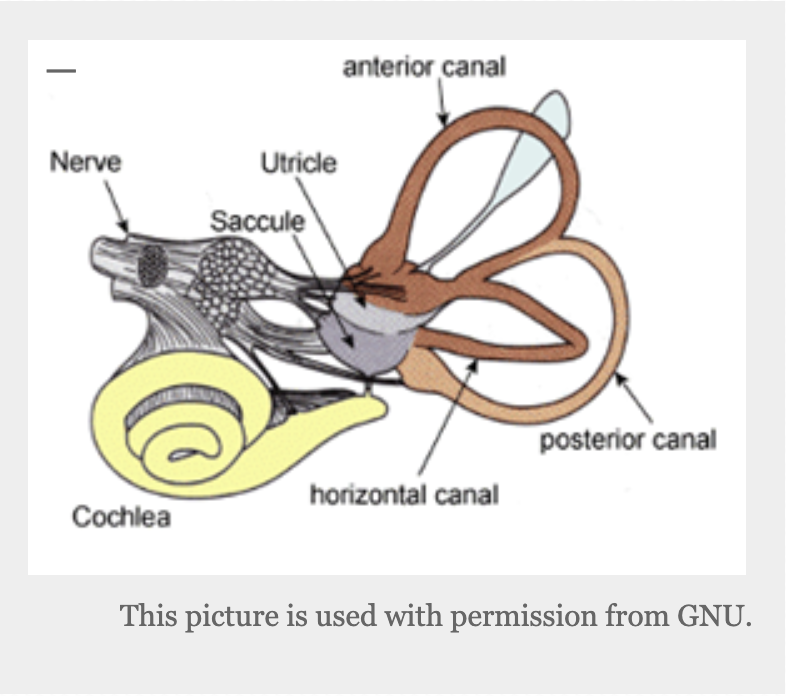If you have arrived on this page, you likely suffer from Benign Paroxysmal Positional Vertigo (BPPV) with motion-induced dizziness symptoms.

Positional Vertigo (BPPV)
If you have arrived on this page, you likely suffer from Benign Paroxysmal Positional Vertigo (BPPV) with motion-induced dizziness symptoms.
Causes:
Otoliths, or “ear-rocks”, are small calcium deposits found in the vestibular system of the inner ear. They serve the important function of stimulating nerve cells to send signals to the brain, part of the overall balance process. In some individuals, the ear rocks may get loose from time to time and fall out of their rightful place in the utricle, part of the vestibular system. When the ear rocks fall into the three semicircular canals, which form another major component of the vestibular system for balance, the signals going to the brain are jumbled. This results in a sensation of dizziness whenever the head moves. Whether the motion-induced dizziness is of the variety of a rapid up-down sensation, a spinning sensation, or some other stomach-churning sensation depends on the location of the ear rocks in the semicircular canals. The occurrence of loose ear rocks in some individuals has been attributed to infections, head injuries and aging. Positional vertigo is often chronic, and the rate of recurrence in some patients can be debilitating and severely affect their quality of life. It has been estimated that 20% or more of all dizziness is due to positional vertigo, and dizziness is one of the most common reasons for doctors’ visits in the US.
Treatments:
BPPV Exercises. The most common treatments when positional vertigo symptoms occur are head maneuver exercises. Those carried out at the doctor’s office are most often the Epley or the Semont maneuvers. Some practitioners develop exercises that are variations of these. All of the head maneuver exercises aim to relocate the loose ear-rocks from the semicircular canal into other areas of the inner ear, preferably back to the utricle. Exercises carried out by trained professionals have a much higher chance of producing positive results than unsupervised exercises. Unfortunately, in order to have these exercises administered by a clinician, the patient needs to be lucky enough to obtain an appointment at the doctor’s office while symptoms are still present. Even then, driving to the doctor’s office while feeling dizzy could be hazardous if a ride is not available. The wait to be seen by a trained clinician may be hours. Those who have been treated successfully by the Epley maneuver can attest to the wondrous feeling of regaining perfect balance after just a few minutes, even though immediately before the exercise the world may have been violently whirling. However, the exercise is not 100% effective.
Many of the those who suffer from positional vertigo have been taught some exercises to self-administer at home. The success rate of the home exercises is quite low (~20% for the Brandt-Daroff exercise). The patient is required to repeat the exercise several times a day, each lasting 15-20 minutes for a period of two weeks or more. Many of these exercises involve inclining the head at an angle (~30 to 45 degrees) and then moving the head to another orientation but at a similar inclined angle. The low success rate means that the dizziness symptoms remain the same and occasionally, may get worse after the laborious and uncomfortable routines that disrupt daily lives. Equally important, the patient may feel helpless and frustrated since it is not easy to see any rhyme or reason for repeatedly moving the head to this or that side and angle.

Resources on BPPV and the head maneuvering exercises
The above is meant only to give the most basic information about BPPV. There are many excellent articles on the internet about this common disease and its treatments written for virtually any audience: medical experts’ research findings, popular science articles written by experts for a general audience, as well as general interest articles by journalists. Below are a few website links to relatively accessible articles with illustrations on the anatomy of the inner ear and the head maneuvering exercises. There are also many videos on www.youtube.com that demonstrate the mechanics of these exercises.
Inner Ear ‘Rock Slides’ Lead To Vertigo (http://www.npr.org/templates/story/story.php?storyId=103463398)
Benign Paroxysmal Position Vertigo (http://american-hearing.org/disorders/benign-paroxysmal-positional-vertigobppv/)
Head Maneuvers Most Effective Treatment for Vertigo (http://www.health.harvard.edu/press_releases/head-maneuvers-most-effective-treatment-for-vertigo)
Epley and Semont Maneuvers for Vertigo (http://www.webmd.com/brain/liberatory-maneuvers-for-vertigo)
Lateral Canal BPPV (http://www.dizziness-and-balance.com/disorders/bppv/lcanalbppv.htm)
